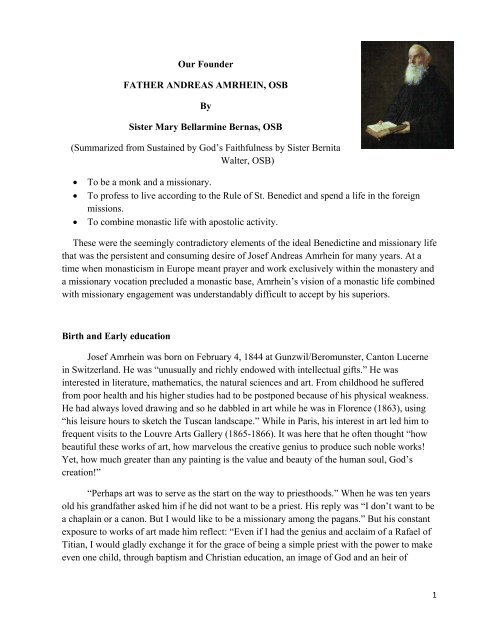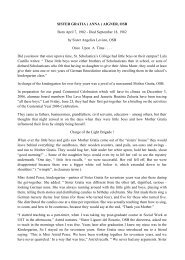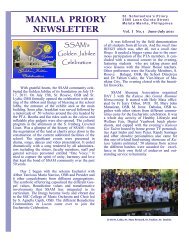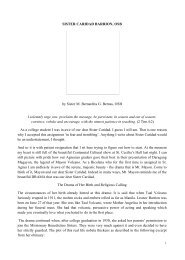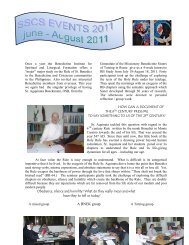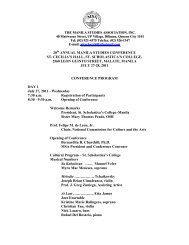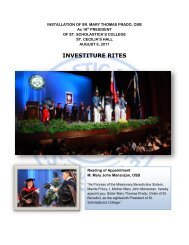Fr. Andreas Amrhein, OSB - St. Scholastica's College
Fr. Andreas Amrhein, OSB - St. Scholastica's College
Fr. Andreas Amrhein, OSB - St. Scholastica's College
You also want an ePaper? Increase the reach of your titles
YUMPU automatically turns print PDFs into web optimized ePapers that Google loves.
Our Founder<br />
FATHER ANDREAS AMRHEIN, <strong>OSB</strong><br />
By<br />
Sister Mary Bellarmine Bernas, <strong>OSB</strong><br />
(Summarized from Sustained by God’s Faithfulness by Sister Bernita<br />
Walter, <strong>OSB</strong>)<br />
• To be a monk and a missionary.<br />
• To profess to live according to the Rule of <strong>St</strong>. Benedict and spend a life in the foreign<br />
missions.<br />
• To combine monastic life with apostolic activity.<br />
These were the seemingly contradictory elements of the ideal Benedictine and missionary life<br />
that was the persistent and consuming desire of Josef <strong>Andreas</strong> <strong>Amrhein</strong> for many years. At a<br />
time when monasticism in Europe meant prayer and work exclusively within the monastery and<br />
a missionary vocation precluded a monastic base, <strong>Amrhein</strong>’s vision of a monastic life combined<br />
with missionary engagement was understandably difficult to accept by his superiors.<br />
Birth and Early education<br />
Josef <strong>Amrhein</strong> was born on February 4, 1844 at Gunzwil/Beromunster, Canton Lucerne<br />
in Switzerland. He was “unusually and richly endowed with intellectual gifts.” He was<br />
interested in literature, mathematics, the natural sciences and art. <strong>Fr</strong>om childhood he suffered<br />
from poor health and his higher studies had to be postponed because of his physical weakness.<br />
He had always loved drawing and so he dabbled in art while he was in Florence (1863), using<br />
“his leisure hours to sketch the Tuscan landscape.” While in Paris, his interest in art led him to<br />
frequent visits to the Louvre Arts Gallery (1865-1866). It was here that he often thought “how<br />
beautiful these works of art, how marvelous the creative genius to produce such noble works!<br />
Yet, how much greater than any painting is the value and beauty of the human soul, God’s<br />
creation!”<br />
“Perhaps art was to serve as the start on the way to priesthoods.” When he was ten years<br />
old his grandfather asked him if he did not want to be a priest. His reply was “I don’t want to be<br />
a chaplain or a canon. But I would like to be a missionary among the pagans.” But his constant<br />
exposure to works of art made him reflect: “Even if I had the genius and acclaim of a Rafael of<br />
Titian, I would gladly exchange it for the grace of being a simple priest with the power to make<br />
even one child, through baptism and Christian education, an image of God and an heir of<br />
1
heavenly glory. This is the true art, the most profound science: to make immortal souls god-like<br />
and pleasing to him.”<br />
“Early in life Josef <strong>Amrhein</strong> manifested a basic generosity, a joy in giving – not only<br />
material but also spiritual gifts.” Perhaps it was also this that led him to consider the priesthood<br />
as a way of sharing his own blessings. “We are very ungrateful and utterly lacking in love. We<br />
have the light, and yet we let millions of others stumble in the darkness.”<br />
In 1866 he went to Karlsruhe to study painting and literature. While he was there “his<br />
priestly vacation became the focus of his thinking.” One Pentecost Sunday, June 9, 1867, Josef<br />
<strong>Amrhein</strong> was awakened by a loud call that clearly said: “Leave everything!” He did not know<br />
for sure whether the experience was a mere “dream, hallucination, or just chance”. However,<br />
“after this Pentecost experience <strong>Amrhein</strong> was sure of his priestly calling.”<br />
Preparing for the Priesthood<br />
In 1868 he moved to Tuebingen to study philosophy and theology. He took great interest<br />
in the lectures of Professor Carl Josef Hefele in a class on church history and Christian<br />
archeology. He was especially impressed by the presentations on religious orders and founders<br />
when it was said that the Christianization of Europe was primarily due to the “peaceful, yet<br />
enduring and blessed labors of the monks of <strong>St</strong>. Benedict.”<br />
The following year, on December 29, 1869, <strong>Amrhein</strong> met for the first time in Tuebingen,<br />
Abbot Maurus Wolter who had refounded Beuron Abbey in 1863. “Seeing Wolter in<br />
Benedictine habit, the young theology student experienced a renewed interest in the<br />
Benedictines.” The following Pentecost (1970) he went for a three-day of retreat in Beuron. He<br />
was very impressed by the solemn liturgy of Beuron and before he left the monastery he<br />
decided to join the monks. “Without doubt it was chiefly his generous heart, ever ready to<br />
follow a call, which prompted <strong>Amrhein</strong>’s quick decision.”<br />
A Monk at the Beuron Abbey<br />
In July 1970 <strong>Amrhein</strong> joined the monks of Beuron Abbey as a candidate and in<br />
December of the same year, he took the name of <strong>Fr</strong>ater <strong>Andreas</strong> as a novice. “On Christmas in<br />
1871 he professed simple perpetual vows, on July 16, 1872, he was ordained a priest, and on<br />
February 2, 1875, he made his solemn profession.”<br />
Writing about <strong>Amrhein</strong>, Sister Bernita Walter raised two crucial questions:<br />
• “Was he aware that Beuron’s monastic life differed considerably from the kind Boniface<br />
and the missionary monks of Germany had lived and which von Hefele’s lectures had<br />
conveyed?<br />
• Had he weighed the fact that his evident vocation to apostolic service would find no<br />
proper expression in Beuron?”<br />
2
Perhaps if <strong>Amrhein</strong> had pondered these questions and ascertained a more definitive direction<br />
of his personal vocation as a monk and missionary before entering Beuron, he might have<br />
decided against becoming a monk in Beuron at all. In his autobiographical sketch (1883)<br />
<strong>Amrhein</strong> refers to this seemingly hasty decision as a “mystery of God’s wise, loving providence”<br />
which prepared him for the particular foundation that he would eventually make. “I was destined<br />
to receive a monastic training which has produced so many holy missionaries who went forth to<br />
convert peoples and lands.”<br />
Persistent call to the Missions<br />
While in Beuron Father <strong>Andreas</strong> was in constant inner conflict, “for the ideal of<br />
combining monastic life with apostolic activity beckoned to him with steady and increasing<br />
urgency, yet there was no prospect of any kind of apostolic work for him.” Because of this, he<br />
wanted to leave before his profession but the abbot dissuaded him. “Abbot Maurus evidently<br />
thought Brother <strong>Andreas</strong>’ monastic calling was genuine, but not his apostolic vocation.”<br />
For many years, Father <strong>Andreas</strong>’ desire for apostolic service remained unabated. His<br />
writings give us an insight into the prayerful discernment process that must have occupied him<br />
during those difficult years.<br />
“Since my profession I have repeatedly asked my superiors’ permission to be sent to the<br />
foreign missions…<br />
• Were I less determined to do God’s will, even to desist from my most cherished desire<br />
for his sake, I might consider this call as a temptation.<br />
• Were I less convinced, despite my submission to God’s will, of my missionary vocation,<br />
I might see it as a source of disquiet, as sheer temptation.<br />
• And had I not known and desired mission work as my vocation even before entering<br />
monastic life, I might consider it a temptation against stability….”<br />
At the New Foundation in Maredsous<br />
Three months after his ordination, he was sent with some other monks for a new<br />
foundation in Maredsous. “Throughout this time his missionary vocation occupied his thoughts,<br />
and when Abbot Maurus visited Maredsous near the end of 1876, <strong>Amrhein</strong> again made his<br />
request. Again he was denied the desired “Yes”.<br />
In spite of the absence of any prospect of realizing his missionary vacation during his<br />
four years stay at Maredsous, his desire to go to the foreign mission became clearer while fanned<br />
by the reports read at table about Benedictines serving in the foreign mission, e.g. the<br />
Silvestrines in Ceylon and Dom Salvado’s missionary monks in New Norcia, Australia. He also<br />
read the mission accounts from Asia and East Africa, especially about the Holy Ghost Fathers in<br />
Bagamoyo (Tanganyika) and of David Livingstone in Zambia. His extensive reading and serious<br />
3
eflection yielded a more concrete leitmotif of the monastic and missionary community that he<br />
was dreaming of.<br />
“In November 1880 Father <strong>Amrhein</strong> wrote down the fruit of his years of reflection in<br />
Maredsous.<br />
• His missionary strategy would not rely on individual missionaries, but center around a<br />
monastic community.<br />
• The monastery would be a home for children and would train young natives in workshops<br />
directed by the brothers.<br />
• Its lands were not only to sustain the community but also to teach the people agriculture<br />
and animal husbandry to make them settle down.<br />
• The beauty of the liturgical celebration was to be a significant attraction in missionary<br />
work.<br />
These fundamental principles animated Father <strong>Amrhein</strong>’s endeavors in succeeding years.”<br />
In 1880, Father <strong>Amrhein</strong> was sent from Maredsous to the “missions” i.e. to teach at the<br />
parish school of Eddington near Birmingham. This was not the kind of mission work that Father<br />
<strong>Amrhein</strong> had in mind. Reminding Abbot Maurus of his promise in 1879 that he could do mission<br />
work if he could “prove his obedience through a three-year period, and his health were good and<br />
his longing for the missions continued” Father <strong>Amrhein</strong> obtained permission to spend six months<br />
with the Mill Hill Fathers in England in March 1880.<br />
Preparatory <strong>St</strong>eps towards the Realization of the Ideal<br />
<strong>Fr</strong>om this time on (1880) until he obtained the permission from Abbot Maurus Wolter to<br />
leave Beuron Abbey (1883) so that he could offer himself to the Propaganda Fide, Father<br />
<strong>Amrhein</strong> spent many uncertain and trying months clarifying the ideal in his mind and searching<br />
for the means to realize this concretely. His search brought him in contact with several founders<br />
of missionary congregations, among them Herbert Vaughan of the <strong>St</strong>. Joseph Society of Mill<br />
Hill, England; Arnold Janssen of the Society of the Divine Word of <strong>St</strong>eyl, Holland; Dr.<br />
<strong>Fr</strong>anziskus M. Jordan of the Salvatorians and Abbot Bishop Rudesind Salvado of New Norcia,<br />
Australia. Except for Salvado’s foundation, all the others had no monastic orientation. Slowly,<br />
but with much difficulty, his concept of a monastic-missionary endeavor began to crystallize.<br />
At Mill Hill<br />
His initial search brought Father <strong>Amrhein</strong> to Mill Hill, an institute for diocesan<br />
missionary priests founded by Herbert Vaughan in 1866. It was here that “he first thought of<br />
establishing an institute for lay missionaries with a Benedictine orientation to support missionary<br />
priests and considered attaching his foundation to an existing group of missionary priests.” His<br />
idea found general acceptance in Mill Hill although some of the superiors questioned its<br />
4
monastic element. Nevertheless, the Mill Hill Fathers were ready to take him in as a full member<br />
of their missionary society. Abbot Maurus, however, asked him to remain a monk of Beuron<br />
Abbey and thus he became only an initial member.<br />
In order to gain practical mission experience, Father <strong>Amrhein</strong> was offered to join the<br />
project of the Mill Hill Fathers in Borneo. He left for Germany to prepare for this trip and to<br />
improve his health. His physician, however, advised him against the journey because of his<br />
health. Further invitations of the Mill Hill Fathers to ask Father <strong>Amrhein</strong> to be a full member and<br />
“cease being a Benedictine monk” prompted him to look elsewhere. He did not want to abandon<br />
the Benedictine base of his future foundation and so he decided to get in touch once more with<br />
Arnold Janssen in <strong>St</strong>eyl.<br />
Disturbing Decisions from Beuron<br />
Meanwhile some decisions were made about Father <strong>Amrhein</strong> at the Beuron Abbey while<br />
he was still in Germany. Abbot Maurus ordered him “to return without delay, either to Mill Hill<br />
or to one of the monasteries of the Beuronese Congregation.” The rector of Mill Hill was<br />
informed that he and Father <strong>Andreas</strong> could ask for his canonical separation from the Holy See.<br />
However, realizing that the trip to Borneo was beyond his physical strength, the abbot was<br />
informed that there was no longer any reason for Father <strong>Amrhein</strong> to join the Mill Hill society.<br />
Abbot Maurus then ordered Father <strong>Amrhein</strong> to return to Maredsous immediately.<br />
Father <strong>Amrhein</strong> was deeply shaken. “His interior anxiety was greater than ever: for<br />
twelve years he had pursued the ideal of missionary work as a Benedictine. Was he to give it up<br />
just before reaching his goal? Should he return to Maredsous and renounce all his missionary<br />
plans or follow his missionary vocation and leave the Benedictine Order?”<br />
In a letter of February 18, 1883, Father <strong>Amrhein</strong> implored Abbot Maurus to rescind his<br />
decision: “I beg on my knees that you not withdraw your permission!...not take from me the goal<br />
of these many years of prayer and longing…just because the first mission institute…which I<br />
desired to join demanded that I leave the Order. If another mission institute will accept me<br />
without this demand, you need not make me unhappy by withdrawing your permission.”<br />
The following week, Father <strong>Amrhein</strong> decided to go on a pilgrimage to Rome “as a final<br />
resort at the last moment.” On his way to Rome, he received the answer to his request to be<br />
allowed to go to <strong>St</strong>eyl where the rector, Arnold Janssen awaited him.<br />
A Pilgrimage to Rome<br />
Through the help of funds from friends, Father <strong>Amrhein</strong> went to Rome “to the sacred<br />
places of the Eternal City and to the Holy Father in order to begin the work of the missions with<br />
the blessing of Peter’s successor.” At the Propaganda Fide he was received by Archbishop<br />
Jacobini who advised him to proceed to <strong>St</strong>eyl to profit from the insights of the flourishing<br />
5
missionary society. He also met with Dr. <strong>Fr</strong>anziskus M. Jordan, the founder of the Salvatorians<br />
and with Abbot-Archbishop Salvado who was visiting in Rome. The latter told him that church<br />
authorities would grant him the required permission if he were able to show a good beginning<br />
and some accomplishments. With this encouraging advice from another Benedictine, Father<br />
<strong>Amrhein</strong> proceeded to <strong>St</strong>eyl.<br />
With Jansen in <strong>St</strong>eyl<br />
While still at Maredsous, Father <strong>Amrhein</strong> kept in touch by letter with Arnold Janssen, the<br />
Rector of <strong>St</strong>eyl. He maintained this correspondence often disclosing to him the result of his<br />
prayer and discernment. In 1979, referring to what he had learned about “Salvado’s months of<br />
waiting before his abbot had allowed him to leave for the missions”, Father <strong>Amrhein</strong> wrote to<br />
Father Janssen: “How often did his example support me in moments of discouragement and<br />
anguish of heart.” And in 1983 he disclosed to him his difficulties while remaining a monk of<br />
Beuron and an initial member of Mill Hill and not receiving the necessary support he needed<br />
from either of them. Because of this candid relationship with Janssen, it was no surprise that<br />
when he had to leave Mill Hill, Father <strong>Amrhein</strong> turned to Janssen “asking his advice and<br />
indicating his wish to attach his institute of brothers to <strong>St</strong>eyl”<br />
Father <strong>Amrhein</strong> was fortunate to have found in Rector Arnold Janssen “a wise, holy, and<br />
kindly counselor.” His “level-headed, mature, and encouraging influence made <strong>Amrhein</strong>’s ideas<br />
emerge more clearly. His long-cherished dream of an institute for brothers proved a mere<br />
preliminary sketch for his real calling: to found a Benedictine congregation for the foreign<br />
missions with a strong engagement by lay brothers.”<br />
A Happy Conclusion of the Search<br />
Rector Janssen would have been ready to accept Father <strong>Amrhein</strong> as a full member but<br />
both realized that this was not his vocation. Father <strong>Amrhein</strong> had arrived at the same insight as<br />
Rector Janssen that his vocation was to found another Benedictine congregation. This meeting of<br />
minds would finally bring Father <strong>Amrhein</strong>’s search to a happy conclusion. On August 21, 1883,<br />
Rector Janssen wrote “very clearly and forcefully to Archabbot Maurus of his conviction that<br />
<strong>Amrhein</strong>’s missionary call was from God. He told the abbot not to oppose it.” On March 25,<br />
1884 after having obtained permission from Abbot Maurus, Father <strong>Amrhein</strong> then proceeded to<br />
offer himself to the Propaganda Fide.<br />
In November of that year he had a second brief meeting with Abbot Rudesind Salvado<br />
from New Norcia while the latter was visiting Brussels. “The experienced missionary was nearly<br />
seventy years old. He advised <strong>Amrhein</strong> urgently to begin his project on a small and modest scale<br />
to make it flourish.” God’s providence would then guide Father <strong>Amrhein</strong> towards the realization<br />
of his goal and dispel the uncertainties that had brought him much anxiety.<br />
6
On November 22, 1883 he left <strong>St</strong>eyl for Regensburg where he was offered to take over<br />
the Reichenbach Abbey, a former Benedictine monastery that was founded in 1118. He had<br />
found a place where to start his dream.<br />
The Beginnings at Reichenbach<br />
Making a start at Reichenbach was fraught with difficulties. Reichenbach was a<br />
Benedictine abbey that was confiscated by the government and secularized in 1803. It was in<br />
terrible disarray after having been abandoned for many years. It needed not just repair but total<br />
renovation to be habitable. However, with the help of donated construction materials and the<br />
work of capable lay brothers who had come to join Father <strong>Amrhein</strong>, the much-needed work on<br />
the dilapidated buildings started. Fortunately, two priests in Regensburg who were interested in<br />
preserving the monastery helped Father <strong>Amrhein</strong> purchase the land and the building. Now he<br />
could proceed to obtain the necessary permit for his foundation.<br />
“In Germany of his day – suffering from the laws of the “Kulturkampf” that were hostile<br />
to religious institutes – he was not allowed to found a monastery. Another kind of foundation had<br />
to be devised.” And so contrary to his wish of establishing from the very beginning a monastery,<br />
a community of monks at prayer and work, Father <strong>Amrhein</strong> had to settle with what he thought<br />
would be allowed – a seminary or a mission house. But even this did not meet the approval of the<br />
government. Finally, after fourteen months of writing and rewriting his “modified application”<br />
on March 15, 1885, he was told that his application which no longer mentioned a “mission<br />
seminary” but “headquarters for a (private) association called ‘Catholic Mission Society for the<br />
African Interior’” would not need government approval. Having obtained government clearance<br />
to go on with his foundation he then proceeded to follow up his application of March 25, 1884<br />
for ecclesiastical approval.<br />
The Blessing of the Propaganda Fide<br />
On May 4, 1884 Pope Leo XIII confirmed the provisional decision of the Propaganda<br />
Fide cardinals to grant Father <strong>Amrhein</strong> the founding of a mission house. However, Father<br />
<strong>Amrhein</strong> was asked to “prepare more detailed plans for the training of candidates. Also he was to<br />
explain whether they would make vows or promises which later, outside Bavaria, could be<br />
pronounced as vows.” Father <strong>Amrhein</strong> lost no time in providing the necessary papers which<br />
“detailed his plans for training the candidates, based on long explanations of the Rule of<br />
Benedict, drawing on the Benedictine missionaries of the Middle Ages.” Likewise information<br />
about Father <strong>Amrhein</strong> was obtained from Abbot Maurus Wolter by the Propaganda Fide.<br />
The cardinals of the Propaganda Fide once more deliberated on his application and on<br />
June 29, 1884, Archbishop Jacobini, the secretary of the Propaganda Fide asked Father <strong>Amrhein</strong><br />
to meet him at the sacristy of <strong>St</strong>. Peter’s. Towards noon Archbishop Jacobini informed him that<br />
Pope Leo XIII had ratified the cardinals’ approval for founding a mission house in Reichenbach<br />
and for the training of candidates.<br />
7
<strong>Fr</strong>om this obscure beginning the new missionary Benedictine congregation would slowly<br />
grow from its first site in Reichenbach and then to Emming, later called <strong>St</strong>. Ottilien. The<br />
foundation developed into what we know now as the Congregation of the Benedictine Fathers of<br />
<strong>St</strong>. Ottilien.<br />
While still in Reichenbach Father <strong>Amrhein</strong> would slowly include women in his<br />
foundation.<br />
Benedictine Sisters for the Foreign Missions<br />
When Father <strong>Amrhein</strong> presented his application for ecclesiastical approval he made no<br />
mention of plans to include women in his foundation. However, further study of the Anglo-<br />
Saxon missions in Germany drew his attention to the medieval Benedictine nuns – Saint Lioba,<br />
Thekla and Walburga who in the 8 th century accompanied <strong>St</strong>. Boniface from the British Isles and<br />
assisted the monks in their missionary endeavors. He realized the valuable contribution that<br />
women monastics could give.<br />
Around this time, there was not only a new awakening of the missionary ideal in Europe<br />
but also a new impetus to involve women as missionaries. In 1882 a congregation of sisters was<br />
started in Mill Hill, a missionary center that was not unknown to Father <strong>Amrhein</strong>. Likewise,<br />
Rector Arnold Janssen, his spiritual adviser of many years, was also starting a community of<br />
women missionaries. Father <strong>Amrhein</strong> was confirmed in his thoughts on including women in his<br />
foundation.<br />
“Wherever a promising mission center of our congregation is founded in a well-populated<br />
area for our missionaries to convert boys and men, a convent of missionary sisters should<br />
be founded simultaneously or soon thereafter to care for the education of girls and<br />
women in Christian living…. These mission helpers…will also care for the sick…. I hope<br />
our holy Mother Scholastica will bring about a motherhouse of “Benedictine Sisters for<br />
the Foreign Missions.”<br />
These initial thoughts would finally lead to the acceptance of the first four women<br />
candidates in Reichenbach on September 24, 1885. This small band of “missionary sisters of<br />
Reichenbach” would later develop and expand and move along with the monks to <strong>St</strong>. Ottilien<br />
and later on to Tutzing in Bavaria.<br />
Father <strong>Amrhein</strong> governed both the men’s and the women’s branches of the Congregation<br />
of <strong>St</strong>. Ottilien until his resignation from office in January 1896.<br />
Eventually, the women’s branch would be officially and canonically separated from the<br />
original foundation and form what we now know as the Congregation of the Missionary<br />
Benedictine Sisters of Tutzing.<br />
Conclusion<br />
8
The breakthrough of the Missionary Benedictine charism in the Church under the<br />
inspiration of Father <strong>Andreas</strong> <strong>Amrhein</strong> spelled out a new spirituality – the synthesis of the<br />
monastic principle with missionary activity. The 72 nd Chapter of the Rule of <strong>St</strong>. Benedict talks of<br />
the Good Zeal of Monks. One cannot help but think of Father <strong>Andreas</strong> <strong>Amrhein</strong> as a<br />
personification of that “good zeal that which monks must foster with fervent love.”<br />
If we count the years between his profession in Beuron (July 16, 1872) when he<br />
experienced a persistent desire to go to the missions and the time Leo XIII ratified the cardinals’<br />
approval of Father <strong>Amrhein</strong>’s founding a mission house in Reichenbach (June 29, 1884) – these<br />
are barely 12 years. Considering his poor health, the arduous task of clarifying the charism of the<br />
congregation at a time when there had been as yet no missionary Benedictine monasteries,<br />
securing the necessary approval from ecclesiastical authorities and searching for financial<br />
support for his foundation, we can only marvel at the accomplishment of this man. His deep faith<br />
and reliance on Divine Providence buoyed him up all the way especially in the midst of<br />
contradictions, deprivation and ill health.<br />
Father <strong>Andreas</strong> <strong>Amrhein</strong> died on December 29, 1927 in <strong>St</strong>. Ottilien before he saw the<br />
flowering of his foundation.<br />
Epilogue:<br />
The Benedictine Order<br />
The tradition of the Benedictine Order is a 1500-year old heritage. Throughout the<br />
centuries its inherent quest for God and an absolute following of Christ has enabled it to open up<br />
to new climates and new cultures with freshness and vitality. Its Rule of life, marked by<br />
prudence and wisdom, has given its followers stability in the common life of prayer and work.<br />
Living under the gaze of God they receive the courage to face the challenges presented by every<br />
new age.<br />
AROUND THE YEAR 500<br />
The Holy Father of Monks, <strong>St</strong>. Benedict, taught the Christian faith to the people in the<br />
valley of Subiaco.<br />
AROUND THE YEAR 600<br />
Pope Gregory the Great sent monks from Rome to England to as bearers of the message<br />
of Christ.<br />
AROUND THE 8 th TO THE 10 th CENTURY<br />
Benedictines crossed over from England to the European mainland in order to establish<br />
the Church among the German and Slavic nations.<br />
9
AT THE END OF THE 19 th CENTURY<br />
The Benedictine Father <strong>Andreas</strong> <strong>Amrhein</strong>, urged by the desire to pass on the gift of faith,<br />
founded both Congregation of the Missionary Benedictine Fathers of <strong>St</strong>. Ottilien and the<br />
Missionary Benedictine Sisters of Tutzing.<br />
AT THE BEGINNING OF THE THIRD MILLENIUM<br />
The Missionary Benedictine Sisters of Tutzing work in six continents and twenty<br />
countries “to proclaim the Gospel among who do not know Christ or where Christ is not<br />
sufficiently known and serve where the Church is in need.” In a life of God-seeking according to<br />
the Rule of <strong>St</strong>. Benedict they help to “awaken the sense of God in our contemporary society and<br />
to make others aware of the integral salvation of the world offered by God in Jesus Christ”<br />
(Constitutions 1, 5).<br />
That in all things God may be glorified.<br />
10


